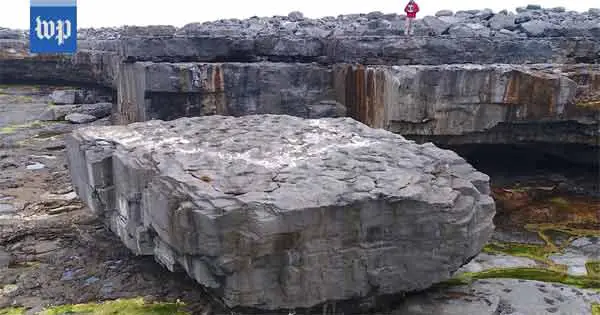A 620-tonne boulder on the Aran islands was moved several metres during a storm, leaving scientists to marvel at the immense power of ocean waves.
The Aran islands are three islands off the west coast of Ireland. They are popular destinations for tourists due to their natural beauty and stunning scenery.
Now a research team led by geoscientist Rónadh Cox have revealed that the boulder – which weighs roughly the same as 90 large African elephants – moved several metres along the biggest of the Aran islands (Inishmore) during the winter of 2013-14.

Cox said that it was one of thousands of that moved along the Irish coasts during the storm.
She said: “We had boulders that were north of 100 tons, sitting tens of meters above sea level and tens of meters inland of the high tide mark, that got moved several meters, or several tens of meters.
“There were boulders that were created from bedrock that were ripped up and disaggregated and the pieces flung into the boulder ridge at 90 meters inland and 15 meters above sea level.”
The scientists believe that the movement of such huge rocks should serve as a terrifying warning of what we can expect in the future as climate change causes more intense coastal storms.
There are two huge boulders of the island of Eleuthera in the Bahamas. One is 925 tonnes and the other weighs 323 tonnes. They both sit on the coast, well above sea level.
It is believed that they are evidence of extreme superstorms that occurred around 100,000 years ago, which was the last time the planet was as warm as scientists predict we are heading. However, other scientists say the rocks could have been lifted onto the coast by a nearby tsunami.
The research by Cox and her team at Williams College is more clear cut as they know where the boulder was before it moved and what weather occurred during the time of the rock moving. They know that there were no tsunamis, just coastal storms.
The team surveyed and photographed rocks on the coast of the Aran Islands and other parts of the Irish west coast. They know when something had moved and what caused the movement.
Their research shows that the landscape is constantly being transformed and rearranged by waves.
The boulder on the Aran islands is the biggest in the world to be documented as having been moved by a storm.
The previous record was held by the 180-tonne boulder that was moved by a typhoon on the Philippine island of Samar.
The weather conditions are considerably different in Ireland. There are no hurricanes. The Aran island rocks were moved by winter cyclones which do not generate the same wind speed as hurricanes but cause huge storm waves.
With the global temperature and sea levels rising some predict that the storms will get ever stronger.
Cox says that her research will be important when it comes to understanding the potential damage that the storms could cause in the future.
She said: “The more intense the storms, the higher the wave energies, so the likelihood of these stronger wave energies hitting in other places becomes greater, as well.
“So I think understanding the dynamics of these deposits in these remote areas is going to matter more as energy levels on coastlines around the world tend to increase.”
Geoscientist Alessio Rovere has previously studied the rocks in the Bahamas He says that Cox’s study shows that there is still plenty we need to learn about wave energy.
He said: “Their study demonstrates that the wave energy developed during storms against cliffs is very large, probably larger than we commonly think.
“Studying how storm wave energy will change on different types of cliffs and under different scenarios of sea level rise is a very intriguing question that will surely keep coastal scientists busy for years to come.”
Cox agrees and says that science is only now beginning to document the vast raw power of the ocean.
She said: “We’re still trying to really measure the upper limits of what’s possible.”
Take a look at te video below from the Washington Post.
Written by Michael Kehoe @michaelcalling